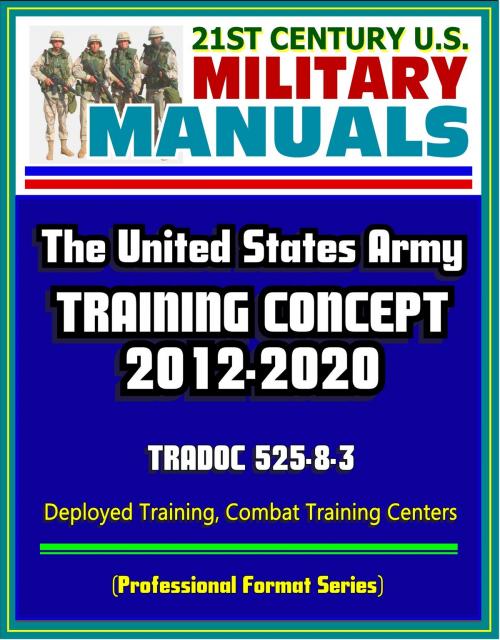21st Century U.S. Military Manuals: The U.S. Army Training Concept 2012-2020, TRADOC 525-8-3, Deployed Training, Combat Training Centers (Professional Format Series)
Nonfiction, History, Military, United States| Author: | Progressive Management | ISBN: | 9781301168743 |
| Publisher: | Progressive Management | Publication: | December 2, 2012 |
| Imprint: | Smashwords Edition | Language: | English |
| Author: | Progressive Management |
| ISBN: | 9781301168743 |
| Publisher: | Progressive Management |
| Publication: | December 2, 2012 |
| Imprint: | Smashwords Edition |
| Language: | English |
Professionally converted for accurate flowing-text e-book format reproduction, The U.S. Army Training Concept 2012-2020 identifies training requirements and capabilities necessary to build and sustain an Army that is adaptable in full-spectrum operations in 2012-2020. It emphasizes the importance of achieving boots-on-ground dwell times that will allow both active Army and Reserve component commanders to manage the training of their units. Cognizant of the need to develop adaptive, flexible, and versatile leaders and units, to operate in a complex operational environment, it recognizes the need for unit training to reflect these realities.
Contents * Foreword * Chapter 1 * Introduction * 1-1. Purpose and scope * 1-2. Background (baseline) * 1-3. Assumptions * 1-4. References * 1-5. Explanation of abbreviations and terms * Chapter 2 * Operational Influence and the Training Environment Context * 2-1. Introduction * 2-2. Operational influence on the training environment * 2-3. The training environment and the OE * 2-4. The training environment and ARFORGEN * 2-5. The operational, institutional and self-development training domains - The training context * 2-6. Key implications * Chapter 3 * Meeting the Challenges * 3-1. Introduction * 3-2. The military problem * 3-3. Central idea: an adaptive training environment to build adaptive units * 3-4. Unit training solution: An ITE * 3-5. Supporting efforts * 3-6. Summary * Chapter 4 * Conclusion * 4-1. Introduction * 4-2. TRADOC Pam 525-8-3 * 4-3. The way-ahead * Section I * Required References * Section II * Related references * Appendix B * Required Capabilities * B-1. Purpose * B-2. Required capabilities * Appendix C * Integrated Training Environment * C-1. Purpose * C-2. Current state * C-3. What is different about the TRADOC Pam 525-8-3 construct? * C-4. Specific outcomes of the ITE * C-5. Specific capabilities * C-6. Conclusion * Appendix D * Framework for Army Training and Education * D-1. Purpose * D-2. Current state * D-3. What is different about the TRADOC Pam 525-8-3 construct? * D-4. Specific outcomes * D-5. Specific capabilities * Appendix E * Network Environment: The Global Network Enterprise Construct (GNEC) * E-1. Purpose * E-2. Current state * E-3. What is different about the TRADOC Pam 525-8-3 construct? * E-4. Specific outcomes * E-5. Specific capabilities * E-6. Conclusion * Appendix F * Home Station Training * F-1. Purpose * F-2. State * F-3. What is different about the TRADOC Pam 525-8-3 construct? * F-4. Specific outcomes * F-5. Conclusion * Appendix G * Combat Training Centers * G-1. Purpose * G-2. Current state * G-3. What is different about the TRADOC Pam 525-8-3 construct? * G-4. Specific outcomes * G-5. Specific capabilities * G-6. Conclusion * Appendix H * Deployed Training * H-1. Purpose * H-2. Current state * H-3. What is different about the TRADOC Pam 525-8-3 construct? * H-4. Specific outcomes * H-5. Specific capabilities
Professionally converted for accurate flowing-text e-book format reproduction, The U.S. Army Training Concept 2012-2020 identifies training requirements and capabilities necessary to build and sustain an Army that is adaptable in full-spectrum operations in 2012-2020. It emphasizes the importance of achieving boots-on-ground dwell times that will allow both active Army and Reserve component commanders to manage the training of their units. Cognizant of the need to develop adaptive, flexible, and versatile leaders and units, to operate in a complex operational environment, it recognizes the need for unit training to reflect these realities.
Contents * Foreword * Chapter 1 * Introduction * 1-1. Purpose and scope * 1-2. Background (baseline) * 1-3. Assumptions * 1-4. References * 1-5. Explanation of abbreviations and terms * Chapter 2 * Operational Influence and the Training Environment Context * 2-1. Introduction * 2-2. Operational influence on the training environment * 2-3. The training environment and the OE * 2-4. The training environment and ARFORGEN * 2-5. The operational, institutional and self-development training domains - The training context * 2-6. Key implications * Chapter 3 * Meeting the Challenges * 3-1. Introduction * 3-2. The military problem * 3-3. Central idea: an adaptive training environment to build adaptive units * 3-4. Unit training solution: An ITE * 3-5. Supporting efforts * 3-6. Summary * Chapter 4 * Conclusion * 4-1. Introduction * 4-2. TRADOC Pam 525-8-3 * 4-3. The way-ahead * Section I * Required References * Section II * Related references * Appendix B * Required Capabilities * B-1. Purpose * B-2. Required capabilities * Appendix C * Integrated Training Environment * C-1. Purpose * C-2. Current state * C-3. What is different about the TRADOC Pam 525-8-3 construct? * C-4. Specific outcomes of the ITE * C-5. Specific capabilities * C-6. Conclusion * Appendix D * Framework for Army Training and Education * D-1. Purpose * D-2. Current state * D-3. What is different about the TRADOC Pam 525-8-3 construct? * D-4. Specific outcomes * D-5. Specific capabilities * Appendix E * Network Environment: The Global Network Enterprise Construct (GNEC) * E-1. Purpose * E-2. Current state * E-3. What is different about the TRADOC Pam 525-8-3 construct? * E-4. Specific outcomes * E-5. Specific capabilities * E-6. Conclusion * Appendix F * Home Station Training * F-1. Purpose * F-2. State * F-3. What is different about the TRADOC Pam 525-8-3 construct? * F-4. Specific outcomes * F-5. Conclusion * Appendix G * Combat Training Centers * G-1. Purpose * G-2. Current state * G-3. What is different about the TRADOC Pam 525-8-3 construct? * G-4. Specific outcomes * G-5. Specific capabilities * G-6. Conclusion * Appendix H * Deployed Training * H-1. Purpose * H-2. Current state * H-3. What is different about the TRADOC Pam 525-8-3 construct? * H-4. Specific outcomes * H-5. Specific capabilities















